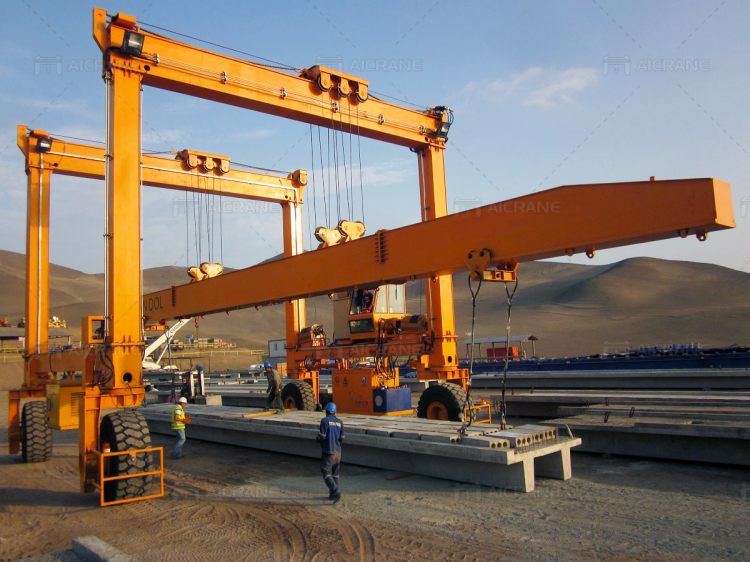In the world of material handling, efficiency and flexibility are key factors in streamlining operations and maximizing productivity. One innovative solution that has gained significant popularity in recent years is the rubber gantry crane. This versatile piece of equipment combines the advantages of a traditional gantry crane with the mobility and flexibility offered by rubber tires. In this article, we will explore the features, benefits, and applications of rubber gantry cranes, highlighting their contribution to enhancing efficiency in various industries.
Features of Rubber Gantry Cranes
Rubber gantry cranes are engineered to meet the demands of modern material handling operations. They are equipped with a range of features that make them highly adaptable and efficient in different environments. Here are some key features:
- Rubber Tires: Unlike traditional gantry cranes that are fixed to a specific location, rubber gantry cranes are mounted on rubber tires. This mobility allows them to move smoothly across a variety of surfaces, including concrete floors, asphalt, and gravel. The rubber tires also provide excellent shock absorption, minimizing vibrations and ensuring stability during lifting and transportation.
- Electric Drive System: Rubber gantry cranes are powered by electric motors, offering several advantages over diesel or gasoline-powered alternatives. Electric drive systems provide cleaner and quieter operation, reducing emissions and noise pollution in the workplace. Additionally, electric motors offer precise control and smooth acceleration, enhancing safety during lifting and positioning tasks.
- Adjustable Height and Span: Rubber gantry cranes feature adjustable height and span capabilities, allowing operators to customize the crane’s configuration to suit the specific requirements of their operations. This adaptability enables the crane to handle a wide range of loads and accommodate different workspace layouts. Furthermore, the adjustable span feature enables operators to maneuver the crane easily within narrow aisles or congested areas.

Safe and Efficient Use of Rubber Gantry Cranes
Using a rubber gantry crane safely and efficiently is crucial to ensure smooth operations, protect workers, and optimize productivity. Here are some guidelines to help you achieve safe and efficient utilization of a rubber gantry crane:
Training and Certification: Ensure that operators are properly trained and certified to operate rubber gantry cranes. Training should cover crane controls, load capacity, safety procedures, and maintenance requirements. Regular refresher courses can help reinforce safe practices and keep operators updated with any new developments or regulations.
Pre-Operation Inspection: Before using the crane, conduct a thorough inspection of the equipment to ensure it is in proper working condition. Check for any signs of damage, loose components, or hydraulic leaks. Verify that all safety devices, such as limit switches, emergency stop buttons, and alarms, are functioning correctly.
Load Capacity and Rigging: Always adhere to the crane’s load capacity limits. Overloading can lead to accidents, damage to the crane, and potential injuries. Use appropriate rigging equipment, such as slings or chains, and ensure they are inspected and in good condition. Properly secure the load to prevent shifting or falling during lifting and transport.
Clear Communication: Establish clear communication protocols between the crane operator and the workers involved in the lifting operation. Use hand signals, two-way radios, or other reliable communication devices to ensure effective communication and coordination. Everyone involved should be aware of their roles and responsibilities during the lifting process.
Environmental Considerations: Assess the working environment before operating the crane. Ensure the ground is level and stable to prevent tipping or instability. Be mindful of overhead obstacles, power lines, or other potential hazards. Adhere to all safety regulations and guidelines specific to your industry or work site.

Safe Lifting Practices: Follow safe lifting practices to minimize the risk of accidents. Lift the load smoothly and avoid sudden movements or jerks. Use the crane’s adjustable height and span features to position the load accurately. Avoid swinging or spinning the load, as this can destabilize the crane and cause the load to swing uncontrollably.
Personal Protective Equipment (PPE): Ensure that all personnel involved in the lifting operation wear appropriate personal protective equipment, such as hard hats, safety vests, gloves, and steel-toed boots. PPE should be in good condition and worn correctly at all times.
Regular Maintenance: Maintain the crane according to the manufacturer’s guidelines and schedule regular inspections. Lubricate moving parts, check hydraulic systems, and inspect the tires for wear and tear. Promptly address any issues or repairs to prevent accidents and ensure optimal performance.
Emergency Preparedness: Develop and communicate an emergency response plan in the event of an accident, equipment failure, or other unforeseen circumstances. Provide training on emergency procedures, including evacuation routes, first aid, and contacting emergency services.
Continuous Improvement: Encourage feedback from crane operators and workers to identify any potential areas for improvement in safety and efficiency. Regularly review and update your safety protocols and procedures to incorporate lessons learned and industry best practices.
By adhering to these guidelines, you can use a rubber gantry crane safely and efficiently, promoting a productive and secure work environment. Remember, safety should always be the top priority, and any concerns or issues should be addressed promptly to ensure the well-being of everyone involved. To get a right and reliable gantry cranes, it matter a lot to choose a reputable crane supplier.
